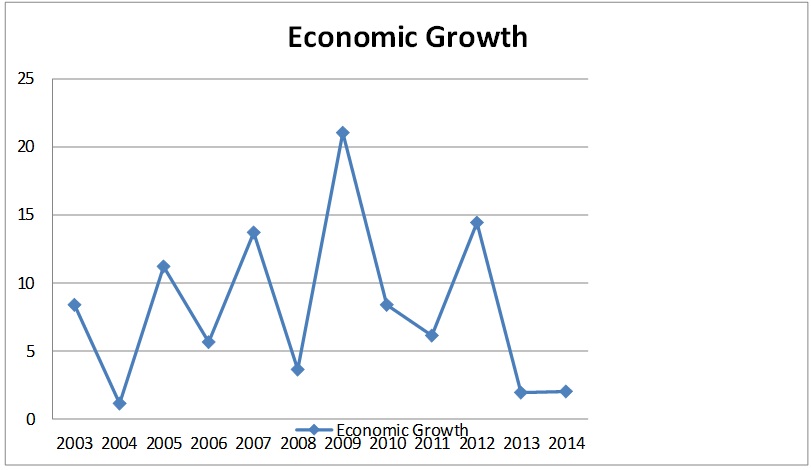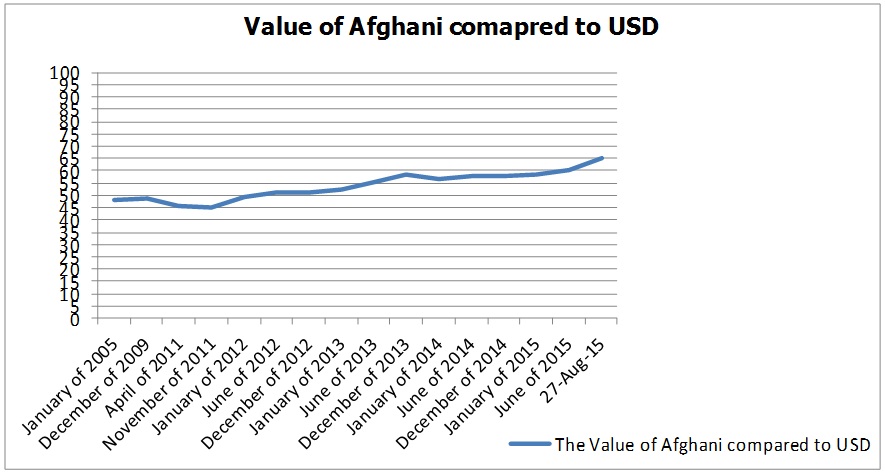Afghanistan Economic Update: the current scenario and the future prospects
According to World Bank statistics, the economy of Afghanistan was somehow going well from 2003 to 2009. But, as the war intensified, political instability increased, and investment decreased due to the announcement of withdrawal of foreign Security forces; the country’s economy moved into recession in 2013 and 2014.
Due to political differences in 2014 and with the Establishment of the National Unity Government (NUG), failing to make a Cabinet on time, the current insecurity, expansion of insurgent activities in the Northern part of the country, and the continuous falling down of districts to Taliban will have negative impacts on Afghan economy in the current year (2015) and next.
Now, Afghanistan faces not only security and political instability, but it is in a very bad economic condition as well. The economic growth is too low, the rate of unemployment increases each day, financial crisis is looming over, private investment is nil and the Afghani (Afghan currency) depreciates day by day. If we considers the last one week (22-29 August), we would realize that Afghani, for the first time in the past ten years, is depreciating against US Dollar by such a large margin.
In this regard, the researchers in the Center for Strategic and Regional Studies (CSRS) have studied and analyzed the current economic situation of the country in this weekly analysis.
Economic Growth
From 2001 to 2012, Afghanistan’s annual average economic growth was 9%. The best year, in this entire period, was 2009, where the economic growth was 21%. But, the economic growth has decreased since 2009. The economic growth was 8.4% in 2010, 6.1% in 2011, 14.4% in 2012, 1.9% in 2013 and 2% in 2014. [1]
Figure 1: Afghanistan Economic Growth (2003-2014)
Source: Statistics for Afghanistan’s Economic Growth are taken form the website of the World Bank.
The reasons of Afghanistan’s low economic growth since 2009 are:
- In 2009, the USA announced their withdrawal from Afghanistan that caused distrust in the field of business;
- From this year, Afghanistan faces insecurity and instability that is increasing day by day.
- The economic growth reached to 14.4% in 2012 only, its main reason was, that year Afghanistan was having good harvest year.
- The businessmen lose confidencein 2013. In this year, disagreements for not signing the Security Agreement became increased with the USA, the country faced security and political instability, the amount of investment decreased, and the investors were worried about the future; as a result, the economic growth for this year was 1.9%.
- The economic growth was 2% in 2014. The reasons behind the lower rate of economic growth in this year were insecurity, political instability, and delay in making the new government after the Presidential Elections; decrease in some expenses of foreign forces after its withdrawal have impacted the economy, also.
According to Asian Development Bank (ADB)’s estimation, Afghanistan’s economic growth for the current year would be 2.5%. ADB assumes this would be only possible, if the security and political environment is stable.; However, if we consider the present conditions, it would be really difficult for government to achieve the 2.5% economic growth.
Financial Budget
According to the semi-annual performance report of the Finance Ministry, domestic revenues both tax and non-tax reached to Afs 52.37B in the six months of 1394 FY showing a shortfall of 5% against the target of Afs. 55.35 B for the six months. Compared with the annual target of 1394(Afs.123.01B) it has completed 43% of it. Relative to six months revenues of last year, Afs 47.4B, it shows an increase of 10%.[2]
Core budget/national budget for 1394 is Afs 436.857B (operating budget Afs 283.969B and core development budget Afs 152.888B). According to what the government claims, domestic revenues shall cover 28% of the core budget in 1394 while the short fall of 72% shall be covered by donors’ assistance to core budget; domestic revenues covered 54 % of the total operating expenditures in the first six months of the year, also. [3]
During the six months of 1394FY, the core budget faced a short fall of Afs 384.4 B. This crisis has increased since 2012. After peaking at 11.6 percent of GDP in 2011/12, Afghanistan’s domestic revenue stagnated in nominal terms and declined precipitously as a share of GDP, to 8.4 percent in 2014. Toward the end of the year the government was running out of cash and announced a fiscal shortfall of $537 million for 2014 as a whole (after existing security and civilian aid). Exceptional financial assistance to cover this gap was requested, and donors provided some $190 million, the remaining shortfall was managed by drastically cutting non-wage operating expenditure (O&M) and stopping discretionary development projects. [4]
Major progress would only be possible if the Afghan government and international partners strongly prioritize bringing about a fiscal turnaround and the government engages in bold actions with proactive international support. [5] An international conference on attracting financial assistance is going to be held in Kabul in the next month; the Presidential Palace (ARG) has already held some meetings regarding this. However, the main hindrance for the government to get international financial assistance is corruption, which needs to be addressed. Of course, the government would consider the filing against 6 high-level officials from the Ministry of Urban Development Affairs & Housing and recovering 50% of Kabul Bank assets as their big achievements; and, both of these incidents would play a role in attracting international assistance. [6]
Trade
The situation of trade in Afghanistan for the first quarter of 1394 was as below:
Afghanistan’s exports were $116.22 Million and its imports were $1.91 B in this quarter. In the first quarter of 1394, most of the imports were from Pakistan which was worth $471 Million. Imports from Iran were worth $453 Million and imports from China were $253 Million. [7]Most of Afghanistan’s imports were including wheat, vegetable oil, diesel, cement, steel, electronic tools, cars, spare parts and construction material.
Similarity, most of Afghanistan’s exports were to Pakistan which were worth $50 Million and then to India which were worth $20 Million. The reason behind increase in Afghanistan’s exports to Pakistan in the first quarter is the lack of rain in Pakistan, that’s why exportation of agricultural goods has increased to Pakistan. [8]
The exports of Afghanistan have increased by 61% in the first quarter of 1394; the main reason is increase in licorices rate in the international market. The other reason behind increase in Afghani exports is that the amount of rain in Afghanistan became higher in the past few years and so the agricultural product is increased, then. That’s why most of Afghanistan’s exports are consists of dry fruits, fresh fruits, licorice, vegetables and seeds. [9]
Overall, Afghanistan’s total trade in the first quarter was worth $2032 Million and its trade deficit was $1799 Million.
The Depreciation of Afghani (Currency)
In 2002-2003, a currency reform occurred in Afghanistan and new Afghani, the Afghan currency, was brought to market. One US Dollar was equivalent to 48 Afghanis in January 2005; but, this increased to 58.27 in 2013. The value of Afghani got better (56.33) in the beginning of 2014; however, it lost its value in the upcoming months due to some reasons including political instability, insecurity and etc.; and on January 2015, the value of Afghani against USD was 60.1 and now (on August 27th) it values 65.16 which is unexampled in the past 14 years. [10]
Here are the main reasons behind the depreciation of Afghani::
- Previously, the value of Afghani was not that much high due to the country’s poor state of economy. Most of the time, Afghani had an artificial values and was dependent on USD.
- The current political and security instability and tangled situation; [11]
- Lack of demand for Afghani in the market; before that, a lot of Afghans were working with foreigners and were receiving salary with USD. They were supplying dollars to the market and were receiving Afghani in exchange. This process that included demand for Afghani and the Afghan government was also supplying dollars to the market in order to appreciate the Afghani, so this was increasing the demand for Afghani in the market which spontaneously was keeping the value of Afghani high, then. Now, as a lot of NGOs are closed or their employees are reduced, so, the demand for Afghani has decreases in the market.
- Increasing the value of USD in the international market and reduce in foreign financial assistance to the country are other reasons for decline in the value of Afghani, [12]s
Source: The webpage of DAB http://dab.gov.af/en/DAB/currency
Unemployment
As there is not accurate statistics for unemployment in Afghanistan, however, some months ago, the head of National Workers Union in a ceremony held for workers international day told Pajhwok News agency that now; almost 13 million people are unemployed or underemployed.[13] The amount of unemployment in Afghanistan is questionable; however, neglecting these statistics, the issue of unemployment is so serious and the number of unemployed people is increasing day by day.
To curb down unemployment temporarily, the agriculture sector should be focused on, because a lot of people in Afghanistan are connected to agriculture. Besides that, Afghanistan’s mine sector has a lot of potentials and it can play an important role in providing employment opportunities.
The End
[1] The statics related to Afghanistan’s Economic Growth are taken from the website of the World Bank.
[2] For further details see the semi-annual performance report 1394 online at:< http://mof.gov.af/Content/files/MoF%20SEMI%20ANNUAL%20PERFORMANCE%20REPORT%201394%20RIMU.pdf>
[3] For further details see the semi-annual performance report 1394 online at: <http://mof.gov.af/Content/files/MoF%20SEMI%20ANNUAL%20PERFORMANCE%20REPORT%201394%20RIMU.pdf>
[4] For further details see William A. Byrd, Afghanistan’s continuing fiscal crisis: No end in sight, United States Institute of Peace, Peace Brief 185, May 2015, see it online:< http://www.usip.org/sites/default/files/PB185-Afghanistans-Continuing-Fiscal-Crisis-No-End-In-Sight.pdf>
[5] Ibid
[6] Weesa Daily
[7] For 1394 first quarter exports see the quarterly reports of Center for Statistics Organization: http://cso.gov.af/Content/files/%D8%B1%D8%A8%D8%B9%20%D8%A7%D9%88%D9%84%20%D9%88%D8%A7%D8%B1%D8%AF%D8%A7%D8%AA%201394.xlsx
[8] For 1394 first quarter exports see the quarterly reports of Center for Statistics Organization: http://cso.gov.af/Content/files/%D8%B1%D8%A8%D8%B9%20%20%D8%A7%D9%88%D9%84%20%D8%B5%D8%A7%D8%AF%D8%B1%D8%A7%D8%AA1394.xlsx
[9] See online: http://www.pashtovoa.com/content/afghan-exports-increase-127727043/1199996.html
[10] the above data is taken from Afghanistan’s central bank (Da afghanistan bank), see it online: http://dab.gov.af/en/DAB/currency
[11] Saraye Shahzada’s exchange union says that due to political and security instability the currency has been badly influenced. see it online:
http://www.spogmairadio.af/spogmai-news/economical/5101-2015-08-11-03-34-50
[12] to read specialists views on this subject, see it online: http://www.bbc.com/pashto/afghanistan/2015/08/150818_ma_dollar_rates_increas_in_afghaistan_
[13] See online: http://www.dailyafghanistan.com/national_detail.php?post_id=127558



